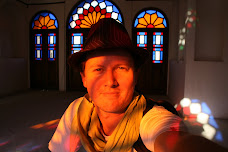The first signs I had to adjust for Iran was the bustle of activity as our plane descended for the landing in Tehran. Women, previously with big bold hairstyles, striking makeup and those Persian eyes, were enveloped in a swirl of brightly coloured and plain scarves, hijab and even the full chador. Even so, as we touched down I prepared for my assumptions to be blasted to smithereens. I was not to be disappointed.
Immigration and customs were a breeze and the airport was clean and efficient. The taxi driver who dashed through the dark freeways and streets of Tehran towards my hotel was probably the oldest living Persian and his car definitely was and after an hour circling the same streets I eventually jumped out and found Damir, a Croatian, banging on our hotel (the Naderi on Jomhuri Eslami Ave) door. I joined him on the doorbell but no matter that our noise was enough to wake the dead, there was no signs of life. By now it is 4am so we settled on a twin in the new Naderi and crashed out.
Slightly dazed and later that morning, we plunged onto the streets of Tehran and were soon wide awake. Tehran is a busy, crowded city similar to Jakarta but more highrises, cars, buses, trucks and motorbikes etc (mostly French made) with some of the maddest ever drivers. As an example they actually accelerate into crowded intersections to try to frighten other drivers to gain the best position and passage through.
We made a quick stop at an internet café to report our safe arrival etc and had the first encounter of the power of the regime. The Iranian Government has blocked Facebook, YouTube and a variety of other sites. Apparently Iran admires China’s ability to control the web and sought their assistance to restrict the access of evil the web provides. Funnily enough, in turn this has led to savvy café managers in Iran to cooperate with Chinese hackers to bypass the filters. I soon learned how to track down these cafés.
We wandered south along Ferdosi towards Imam Khomeni square and I noticed more and more images of the 12 (Or is it 13? Or 14?) imams, often flanked by Supreme Leader Ayatollah Khomeini, his successor Khameni and President Ahmadinejad. Their sublime and youthful faces would follow me, much like Syria’s Asad, all over the country. Also almost every town has an Imam square, Imam Mosque and Imam boulevard. The main one in Tehran has a serious-looking, squat 20-story government building with giant antennas and satellite dishes on top. It is not marked on the map in Lonely Planet and I couldn’t find anyone to tell me exactly who worked there.
The main streets south of Jomhuri were lined with many shops – selling suits, spices, carpets, brassware, bread, sweets (more on this later), juice in blenders and sewing machines. People are busy but there is virtually no hassle to buy. We headed further south past the Golestan Palace and Den of Espionage (former US Embassy where CIA executed the coup) to the Tehran Bazaar. Here was our first dose of Persian architecture in Iran – the Imam Khomeini Mosque. With its magnificent arched entranceway and serene courtyard, cooling vines, turquoise and yellow pool plus the niches inlaid with stunning blues, turquoise, greens and yellows. We met a local guy called Majid and whilst I think Damir was a bit apprehensive at first, the legend of Persian hospitality was on my mind. So we let him draw us in with his tales of the mosque’s history and he was soon keen to show us around the bazaar where he worked. Now I am keen to buy a carpet so thought I could bear a session. But first Majid insisted on taking us to another of the mosques deep inside the bazaar, this one glittered with mirror and glasswork and contained the mausoleum of Imam Reza (I think) which the faithful touched with their hands and foreheads. We stopped briefly at Majid’s shop and in the alleys and shops around it I saw the most amazing collection of carpets - old and new, big and small. The bazaaris (shop owners) play an important economic and political role in Iran, handling much of the foreign exchange and 25% of retail trade. Once they shut this down completely in response to a road they didn’t like, creating chaos and sending a clear message to the government. Nice.
Not being ready to buy a carpet, we were taken by the arm by a friend of Majid through the winding alleys and lanes to the south of the bazaar where we found the famous Khayyam Restaurant – we flopped into expansive cushion chairs in the richly decorated room with high ceilings and murals (or were they frescoes?) and sipped on mint tea, accompanied by dates, cucumbers, sticky pastry wrapped sweets and of course, the qalyan. Qalyan is Farsi for my trusted friend, the nargileh, sheesha, hookah or waterpipe.
Heading back to the Naderi we had our first encounter with the security forces when a passing police car called us over and pointed to Damir’s bag. As Damir motioned to give it to them I stopped him, remembering tales of fake cops (in a marked police car?). It turned out they were just advising him to keep his bag safe and beware of bag snatchers. We scoured the city streets for a decent meal but had to settle for some take away lamb rolls and fizzy orange drink. Checked email to find my dear friend, Lana, had been delayed in Tokyo so decided to head south the following day and wait for her to arrive to explore Tehran and beyond together.
Subscribe to:
Post Comments (Atom)

No comments:
Post a Comment
Note: only a member of this blog may post a comment.